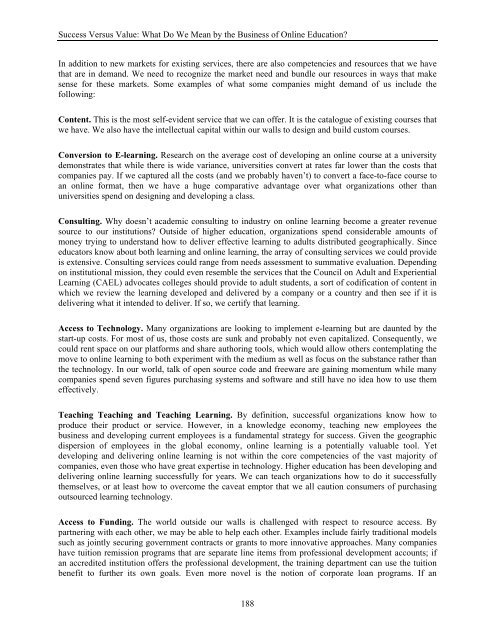Elements of Quality Online Education cation
Elements of Quality Online Education cation
Elements of Quality Online Education cation
Create successful ePaper yourself
Turn your PDF publications into a flip-book with our unique Google optimized e-Paper software.
Success Versus Value: What Do We Mean by the Business <strong>of</strong> <strong>Online</strong> <strong>Edu<strong>cation</strong></strong>?In addition to new markets for existing services, there are also competencies and resources that we havethat are in demand. We need to recognize the market need and bundle our resources in ways that makesense for these markets. Some examples <strong>of</strong> what some companies might demand <strong>of</strong> us include thefollowing:Content. This is the most self-evident service that we can <strong>of</strong>fer. It is the catalogue <strong>of</strong> existing courses thatwe have. We also have the intellectual capital within our walls to design and build custom courses.Conversion to E-learning. Research on the average cost <strong>of</strong> developing an online course at a universitydemonstrates that while there is wide variance, universities convert at rates far lower than the costs thatcompanies pay. If we captured all the costs (and we probably haven’t) to convert a face-to-face course toan online format, then we have a huge comparative advantage over what organizations other thanuniversities spend on designing and developing a class.Consulting. Why doesn’t academic consulting to industry on online learning become a greater revenuesource to our institutions? Outside <strong>of</strong> higher edu<strong>cation</strong>, organizations spend considerable amounts <strong>of</strong>money trying to understand how to deliver effective learning to adults distributed geographically. Sinceeducators know about both learning and online learning, the array <strong>of</strong> consulting services we could provideis extensive. Consulting services could range from needs assessment to summative evaluation. Dependingon institutional mission, they could even resemble the services that the Council on Adult and ExperientialLearning (CAEL) advocates colleges should provide to adult students, a sort <strong>of</strong> codifi<strong>cation</strong> <strong>of</strong> content inwhich we review the learning developed and delivered by a company or a country and then see if it isdelivering what it intended to deliver. If so, we certify that learning.Access to Technology. Many organizations are looking to implement e-learning but are daunted by thestart-up costs. For most <strong>of</strong> us, those costs are sunk and probably not even capitalized. Consequently, wecould rent space on our platforms and share authoring tools, which would allow others contemplating themove to online learning to both experiment with the medium as well as focus on the substance rather thanthe technology. In our world, talk <strong>of</strong> open source code and freeware are gaining momentum while manycompanies spend seven figures purchasing systems and s<strong>of</strong>tware and still have no idea how to use themeffectively.Teaching Teaching and Teaching Learning. By definition, successful organizations know how toproduce their product or service. However, in a knowledge economy, teaching new employees thebusiness and developing current employees is a fundamental strategy for success. Given the geographicdispersion <strong>of</strong> employees in the global economy, online learning is a potentially valuable tool. Yetdeveloping and delivering online learning is not within the core competencies <strong>of</strong> the vast majority <strong>of</strong>companies, even those who have great expertise in technology. Higher edu<strong>cation</strong> has been developing anddelivering online learning successfully for years. We can teach organizations how to do it successfullythemselves, or at least how to overcome the caveat emptor that we all caution consumers <strong>of</strong> purchasingoutsourced learning technology.Access to Funding. The world outside our walls is challenged with respect to resource access. Bypartnering with each other, we may be able to help each other. Examples include fairly traditional modelssuch as jointly securing government contracts or grants to more innovative approaches. Many companieshave tuition remission programs that are separate line items from pr<strong>of</strong>essional development accounts; ifan accredited institution <strong>of</strong>fers the pr<strong>of</strong>essional development, the training department can use the tuitionbenefit to further its own goals. Even more novel is the notion <strong>of</strong> corporate loan programs. If an188
















